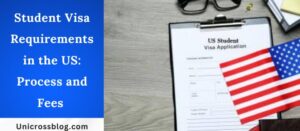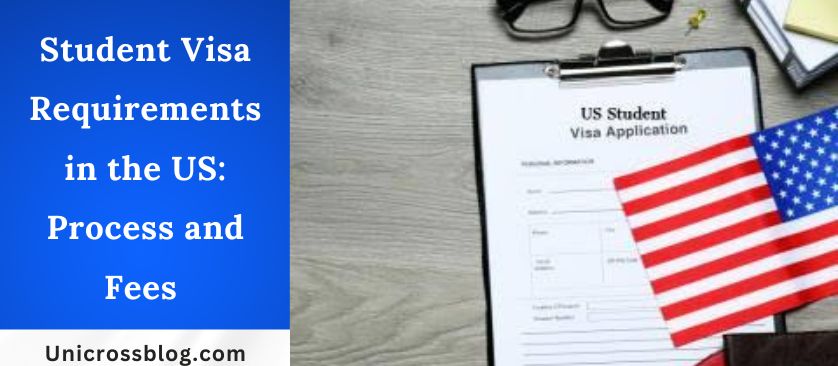As an international student wishing to pursue your studies in the United States, navigating the student visa requirements and application process is an essential step. With careful planning and attention to detail, you can set yourself up for success in obtaining your student visa.
This article will guide you through the key requirements, fees, and steps for the visa application, including eligibility criteria, supporting documentation, and more. Gaining insight into the student visa process will empower you to submit a strong application and achieve your academic goals in the U.S. By following the recommendations outlined here, you can feel confident every component of your visa application is handled properly for your best chance at approval.

What is Student Visa?
A student visa is an official document issued by the U.S. government that allows international students to legally enter the United States for the purpose of study at an accredited U.S. college or university. Student visas are non-immigrant visas, meaning the visa holder intends to return to their home country after completing their studies.
Types of Student Visas
The most common student visa types are:
- F-1 Visa: For academic studies including associate’s, bachelor’s, master’s and doctoral degrees. F-1 visas are the most common for university and college students.
- J-1 Visa: For exchange visitor programs including internships, residencies, and cultural exchange programs. J-1 visas are popular for students interested in cultural exchange and internship programs.
- M-1 Visa: For non-academic or vocational studies including technical and vocational schools. M-1 visas are for students enrolled in vocational or technical schools.
Eligibility Requirements for a US Student Visa
To be eligible for a US student visa, you must meet several requirements. First, you must have been accepted to an SEVP-certified school in the US. The school will provide you an I-20 form to prove your acceptance.
You must prove that you have enough funds to cover your tuition and living expenses for the entire duration of your study. While the required amount depends on the school and program, you will generally need evidence of at least $30,000 to $50,000 per year in funding. This can be shown through personal funds, scholarships, student loans, or sponsor funds from a friend or family member.
In addition, you must prove that you have strong ties to your home country and intend to return after your studies. This can be demonstrated through employment, family, or property that will require you to return home. The consular officer will evaluate the strength of these ties during your interview.
You must pay the required nonimmigrant visa application fees, including the SEVIS I-901 fee. For student visas, the fees are $160 plus a possible extra surcharge. The SEVIS fee is $350.
Finally, you will need to schedule an interview at the U.S. embassy or consulate in your country. At the interview, you must convince the consular officer that you meet the eligibility criteria for the student visa. Be prepared to discuss your program of study, funding sources, and ties to your home country. With the proper documentation and a persuasive interview, you will be well on your way to obtaining a student visa for study in the United States.
READ ALSO: How to Apply for U.S. Immigration Visas in 2024
Step-by-Step Process to Apply for a US Student Visa
To obtain a student visa for studying in the United States, you will need to follow a multi-step application process. First, you must be accepted into a Student and Exchange Visitor Program (SEVP)-certified school. Once accepted, the school will provide you an I-20 form, which is required for the visa application.
1. Submit Visa Application and Documentation
You will need to submit a completed visa application, Form I-20, proof of SEVIS I-901 fee payment, a valid passport, a photo, and any additional documentation requested by the U.S. embassy or consulate. The SEVIS fee can be paid online at fmjfee.com. Schedule your F-1 visa interview at the nearest embassy or consulate in your home country.
2. Attend the Visa Interview
The purpose of the interview is to determine if you meet the requirements to be granted a student visa. Be prepared to discuss details about your course of study, living arrangements in the U.S., and future goals. You will also need to provide evidence that you have sufficient funds to cover tuition and living expenses during your program. The interviewer may ask about your family, education, work experience, and reasons for wanting to study in America.
3. US Port of Entry
If your student visa is approved, you can enter the U.S. no more than 30 days before the start date on your I-20 form. When entering at a port of entry, be prepared to present your student visa, I-20 form, evidence of financial support, and SEVIS fee payment receipt to the U.S. Customs and Border Protection (CBP) officer. The CBP officer will review your documents and may ask you some questions to verify the purpose of your stay before allowing admission into the country.
Obtaining a student visa requires advanced preparation and patience. However, if you follow all the necessary steps and provide complete documentation about your education plans in the U.S., you have a good chance of securing your student visa. Once admitted, you can begin your exciting journey studying in America!
Student Visa Application Fees and Costs
To apply for a student visa to study in the United States, you will need to pay certain required application fees. The fees you must pay include the visa application fee and the SEVIS I-901 fee.
The non-refundable visa application fee must be paid when you attend your visa interview at the U.S. embassy or consulate. For most student visa applicants, the fee is $160. However, citizens of certain countries may have to pay an additional $190 reciprocity fee, depending on the specific visa category. These reciprocity fees are imposed on applicants from certain countries in exchange for the fees the U.S. charges citizens of those countries for certain types of U.S. visas.
In addition to the visa application fee, you must pay the I-901 SEVIS fee to register in the Student and Exchange Visitor Information System (SEVIS). The SEVIS I-901 fee for F and M student visas is $350. This fee must be paid before attending the visa interview and before the U.S. embassy or consulate can issue your student visa. There are a few ways to pay the I-901 SEVIS fee, including online using a credit/debit card, electronic check, Western Union, or mail.
Interview
When attending your visa interview, be prepared to present evidence of having paid both the visa application fee and SEVIS I-901 fee. Failure to pay required fees may result in the delay or denial of your student visa. While the costs to obtain a U.S. student visa may seem substantial, the opportunity to study in America can provide lifelong benefits. With proper financial planning and preparation, paying the necessary visa fees should not pose an insurmountable obstacle for most aspiring international students.
In summary, to apply for a U.S. student visa, you must pay:
- The non-refundable visa application fee (typically $160, some countries $190)
- The SEVIS I-901 fee ($350) to register in the student database
Be prepared to present receipts as evidence of fee payment at your visa interview. Paying required costs, while not negligible, should not deter motivated students from pursuing a U.S. education.
FAQs
What are the general eligibility requirements for an F-1 student visa to the USA?
To be eligible for an F-1 student visa, you must meet the following requirements:
- You must be accepted into a US university or college’s full-time academic program. The school must be approved by the US Department of Homeland Security to accept international students.
- You must be proficient in English or be enrolled in courses leading to English language proficiency.
- You must have sufficient funds to cover your tuition and living expenses during your entire study program. The school will issue you an I-20 form to show you have met this requirement.
- You must maintain a residence abroad which you have no intention of abandoning.
- You must be a bona fide student seeking to enter the US temporarily and solely for the purpose of pursuing study at an established institution.
- You must not have a criminal record that makes you inadmissible to the US. Certain health-related conditions and past immigration violations may also make you ineligible.
- You must not work off-campus without proper authorization. On-campus employment is allowed for up to 20 hours per week.
- You must carry a full course of study each term to maintain your student status.
What documents are required for the F-1 student visa application?
To apply for an F-1 student visa, you will need to submit the following documents:
- A completed visa application form (Form DS-160). This must be submitted electronically on the official website.
- A valid passport. Your passport must be valid for at least six months beyond your intended period of stay in the US.
- An acceptance letter from your school. This should be the official letter of admission or I-20 form issued by your school.
- Evidence of financial support. Examples include bank statements, funding letters, and tax returns showing your sponsor’s income.
- Standardized test scores (if required). Certain schools may require scores from tests like the TOEFL, SAT, ACT or GRE.
- A visa interview fee payment receipt. The fee must be paid before scheduling your interview appointment.
- A photo. You must submit a 2-inch by 2-inch photo that meets the US visa photo requirements.
- Additional documents (if requested). The embassy may request additional documents to verify information in your application. Be prepared to provide any requested evidence.








